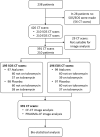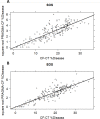Chest computed tomography outcomes in a randomized clinical trial in cystic fibrosis: Lessons learned from the first ataluren phase 3 study
- PMID: 33141825
- PMCID: PMC7608929
- DOI: 10.1371/journal.pone.0240898
Chest computed tomography outcomes in a randomized clinical trial in cystic fibrosis: Lessons learned from the first ataluren phase 3 study
Abstract
A phase 3 randomized double blind controlled, trial in 238 people with cystic fibrosis (CF) and at least one nonsense mutation (nmCF) investigated the effect of ataluren on FEV1. The study was of 48 weeks duration and failed to meet its primary endpoint. Unexpectedly, while FEV1 declined, chest computed tomography (CT) scores using the Brody-II score as secondary outcome measures did not show progression in the placebo group. Based on this observation it was concluded that the role of CT scans in CF randomized clinical trials was limited. However, more sensitive scoring systems were developed over the last decade warranting a reanalysis of this unique dataset. The aim of our study was to reanalyse all chest CT scans, obtained in the ataluren phase 3 study, using 2 independent scoring systems to characterize structural lung disease in this cohort and to compare progression of structural lung disease over the 48 weeks between treatment arms. 391 study CT scans from 210 patients were reanalysed in random order by 2 independent observers using the CF-CT and Perth-Rotterdam Annotated Grid Morphometric Analysis for CF (PRAGMA-CF) scoring systems. CF-CT and PRAGMA-CF subscores were expressed as %maximal score and %total lung volume, respectively. PRAGMA-CF subscores %Disease (p = 0.008) and %Mucus Plugging (p = 0.029) progressed over 48 weeks. CF-CT subscores did not show progression. There was no difference in progression of structural lung disease between treatment arm and placebo independent of tobramycin use. PRAGMA-CF Chest CT scores can be used as an outcome measure to study the effect of potential disease modifying drugs in CF on lung structure.
Conflict of interest statement
JM worked at the time of the manuscript preparation at PTC and owns stock of PTC, he supplied us with relevant data when requested and he critically read the manuscript and gave relevant input where needed fulfilling all requirements for co-authorship. EK received a research grant through his hospital to perform the ataluren Phase III study and acted as Medical & Scientific Consulting Board member and received reimbursement for his time and for travel expenses. HT is director of the Erasmus MC LungAnalysis laboratory, he is a co-inventor of PRAGMACF which is patented. All financial aspects of the patent are handled by the Erasmus MC.
Figures




References
-
- Kerem E, Konstan MW, De Boeck K, Accurso FJ, Sermet-Gaudelus I, Wilschanski M, et al. Ataluren for the treatment of nonsense-mutation cystic fibrosis: a randomised, double-blind, placebo-controlled phase 3 trial. Lancet Respir Med 2014: 2(7): 539–547. 10.1016/S2213-2600(14)70100-6 - DOI - PMC - PubMed
Publication types
MeSH terms
Substances
LinkOut - more resources
Full Text Sources
Medical

